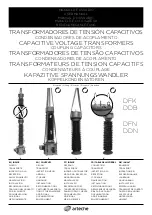
52
52
7.7 pH MEASUREMENT
NOTE
The pH measurement submenu appears only if the transmitter has been configured to measure
free chlorine. pH is not available with any other measurement.
7.7.1 Purpose
this section describes how to do the following:
1. Enable and disable automatic pH correction for free chlorine measurements
2. Set a pH value for manual pH correction
3. Enable and disable pH sensor diagnostics
4. Set upper and lower limits for glass impedance diagnostics
5. Enable and disable automatic pH calibration
6. Set stability criteria for automatic pH buffer calibration.
7.7.2 Definitions
1. AutoMAtIC pH CoRRECtIoN. Free chlorine is the sum of hypochlorous acid (HoCl) and hypochlorite ion (oCl-).
the relative amount of each depends on pH. As pH increases, the concentration of HoCl decreases and the concen-
tration of oCl- increases. Because the sensor responds only to HoCl, a pH correction is necessary to properly con-
vert the sensor current into a free chlorine reading. the transmitter uses both automatic and manual pH correction. In
automatic pH correction the transmitter continuously monitors the pH of the sample and corrects the free chlorine read-
ing for changes in pH. In manual pH correction, the user enters the pH of the sample. Generally, if the pH changes
more than about 0.2 units over short periods of time, automatic pH correction is best. If the pH is relatively steady or
subject only to seasonal changes, manual pH correction is adequate.
2. REFERENCE oFFSEt. the transmitter reading can be changed to match the reading of a second pH meter. If the dif-
ference (converted to millivolts) between the transmitter reading and the desired value exceeds the programmed limit,
the transmitter will not accept the new reading. to estimate the millivolt difference, multiply the pH difference by 60.
3. pH SENSoR dIAGNoStICS. the transmitter continuously monitors the pH sensor for faults. A fault means that the
sensor has failed or is possibly nearing failure. the only pH sensor diagnostic available in the 5081-A is glass imped-
ance.
4. GLASS IMPEdANCE. the transmitter monitors the condition of the pH-sensitive glass membrane in the sensor by
continuously measuring the impedance across the membrane. typical impedance is 100 to 500 M
W
. A low impedance
(<10 M
W
) means the glass membrane has cracked and the sensor must be replaced. An extremely high impedance
(>1000M
W
) implies that the sensor is aging and may soon need replacement. High impedance might also mean that
the glass membrane is no longer immersed in the process liquid.
5. AutoMAtIC pH CALIBRAtIoN. the transmitter features both automatic and manual pH calibration. In automatic cal-
ibration, screen prompts direct the user through a two-point buffer calibration. the transmitter recognizes the buffers
and uses temperature-corrected values in the calibration. the table in Section 13.1 lists the standard buffers the trans-
mitter recognizes. the transmitter also recognizes several technical buffers: Merck, Ingold, and dIN 19267. during
automatic calibration, the transmitter does not accept data until programmed stability limits have been met.
6. MANuAL pH CALIBRAtIoN. If automatic pH calibration is deactivated, the user must perform a manual calibration. In
manual calibration the user judges when readings are stable and manually enters the buffer values.
Because manu-
al calibration greatly increases the chance of making an error, the use of automatic calibration is strongly rec-
ommended.
MODEL 5081-A
SECTION 7.0
PROGRAMMING
















































